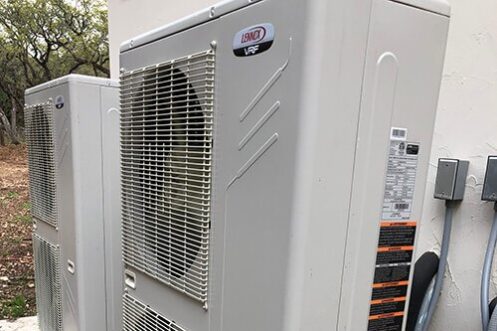
HVAC technology has advanced so rapidly that we now have access to many different cooling options in the San Antonio, TX, area. With the summers in San Antonio being hot and humid, you might be considering whether it is time to change your air conditioning system to something else.
If your system is old and needs replacement, or you are considering moving in another direction to get something better. A variable refrigerant flow (VRF) air conditioning system could be the right choice. VRF systems are relatively new, invented in 1982 by a Japanese company called Daikin Industries.
What Is a VRF Air Conditioning System?
A VRF air conditioning system is similar to a ductless mini split in that a single condenser can be connected to multiple air handling units. A VRF system adds an air conditioning inverter, which is a DC inverter that is connected to the compressor to allow for variable motor speed. That means the system can vary the speed of the compressor instead of being either on or off. That means your unit is more efficient because it does not need to run at full capacity to cool a room.
VRF systems also allow for independent control of multiple air conditioning zones, like a ductless mini split. As energy codes get tighter, VRF air conditioning systems will become more popular.
How Does It Work
The system works similarly to a ductless mini-split in that you don’t have to install massive ductwork to connect the condenser to the air handling unit or units. Like a ductless mini split system, only a small pipe is needed to circle refrigerant. The refrigerant is used as both a heating and a cooling medium, meaning you don’t need a separate furnace and air conditioning system.
Depending on the specific system you select, it can detect when no one is inside a room. It can then adjust the temperature to a less comfortable one. Because of the energy requirements, solar panels can be used because they provide DC power.
Types of VRF AC Systems
When it comes to VRF air conditioning systems, you have three types to choose from. One type only cools, while the other two types can cool and heat. Of the two types that can cool and heat, only one can do this simultaneously in different parts of the home. That is quite impressive, and it adds extra efficiency to your system. However, it should be noted that this last type is more complex and requires extra refrigerant lines. That might not be feasible if you’re only looking at a simple retrofit instead of the extensive work needed to integrate a VRF system into your property.
Usually, the two-in-one option is best because you don’t need separate air conditioning and heating units. However, this could be a good option if you already have a functioning heating system in place. San Antonio winters are mild, but it can get below freezing.
The most popular option is a heat pump system. It can do both cooling and heating, but the unit must be set to one or the other. Some areas of your home or business might typically be much hotter or colder than other areas. That means this type of system might leave certain areas uncomfortably hot or cold.
The third system can effectively heat and cool certain areas at the same time. It works by transferring heat from one room to another. This system is the most complicated but is also efficient for various use cases. If you choose the third type of VRF system, you can heat and cool simultaneously with the same unit. On top of that, it works more efficiently because it takes waste heat from the area being cooled and takes it to where you need to heat. However, as mentioned above, you might require extra refrigerant lines to make it work.
VRF Compared to Typical HVAC
A VRF air conditioning system is more modern than a traditional HVAC system. You might have one or multiple air compressors outside connected to one or more air handling units inside. However, unlike a traditional HVAC system, a VRF air conditioning system requires no ductwork. You only have refrigerant lines that circulate coolant connected to a small air handling unit, which is similar to what you find with ductless mini splits.
The other more significant difference between a VRF and a traditional HVAC system is the inverter. This allows the VRF’s air compressor to vary its speed. Speed variability is the major innovation because you only need to circulate as much refrigerant as needed. It means your system will never over or underwork.
Benefits of VRF Air Conditioning Systems
Overall, a VRF air conditioning system has several benefits that make it a worthwhile choice. The first and most obvious is that it provides consistency you don’t get with a traditional HVAC system or a ductless mini split. Since this type of system delivers a continuous but variable flow, you get constant humidity control. It can also eliminate hot and cold spots.
Because a VRF system allows zoning, people can enjoy the exact temperature they want. You no longer have to sacrifice the comfort of one group over another. For example, you might like it much colder than other people inside and end up fighting with them over the temperature setting.
Another benefit is that it is much quieter than a traditional system. The air handlers used in these systems are much smaller and quieter than a traditional HVAC unit. With traditional central systems, you have a powerful blower motor to push air throughout the entire building. These air handlers only need to circulate air within a smaller space. Also, because of the variable speed, it can run continuously at a lower speed. You also don’t have the bulky ductwork associated with a traditional system. You might be familiar with the rattling and whistling noises that come from ductwork.
The fact that it is similar to a ductless mini split also means you can install it in areas where a central, ducted system might not be feasible. You won’t need to install any air ducts or large air handers, meaning the work required will be much less. You also won’t need to damage your home because the cooling lines are pretty small compared to the ducting that goes into traditional HVAC systems.
Finally, VRF systems are more robust and reliable, meaning they won’t break down as often as other units. Stress is lessened in this unit because it only works when needed and doesn’t work harder than required.
Reasons to Get a VRF Air Conditioning System
You should get a VRF air conditioning system to upgrade to something more efficient, reliable, and quiet. You can look at these systems as the future of HVAC technology, and they will continue to grow in popularity as time goes on. It will also reduce your power usage, meaning lower energy bills.
Reasons Not to Get a VRF AC System
The main drawback of a VRF air conditioning system is the cost. They have a much higher upfront cost than traditional HVAC systems. However, the benefits are so overwhelming that this is a system to upgrade to when that time comes. Your carbon footprint and monthly utility bills should be much lower.
At Beyer Air Conditioning & Heating, we take pride in being San Antonio’s trusted air conditioning, heating, and VRF servicing company. We have extensive knowledge of these systems, and our team of professionals can help you with HVAC repair, installation, and maintenance. We also offer duct cleaning and repair and indoor air quality services. Contact us to schedule an appointment today.



